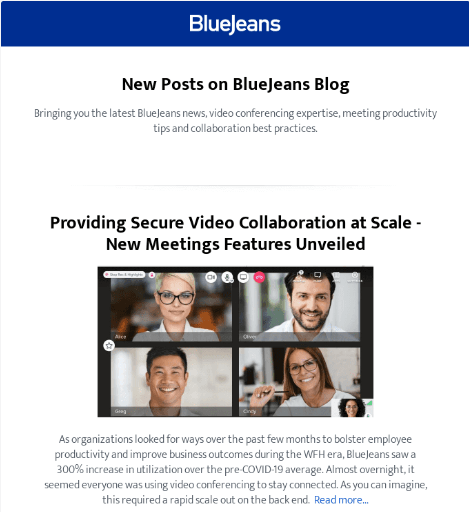-
 Published: Apr 28, 2023
Published: Apr 28, 2023
-
 10 min. read
10 min. read
-
 Macy Storm
Macy Storm Content Marketing Consultant
Content Marketing Consultant
- Macy is a content marketing consultant with over five years of experience creating content for dozens of industries including home services, recreation, and education. She’s written about every marketing topic under the sun, from SEO to AI to email marketing. Her work has been featured by Search Engine Journal, HubSpot, Entrepreneur, Clutch, and more. In her free time, Macy enjoys crafting, reading comic books, and walking her dog Daisy.
Did you know that 56% of people prefer to shop online over at a physical store? More people turn to online shopping experiences to get what they need. As a result, virtual selling has taken the driver’s seat for online businesses.
On this page, we’ll cover everything you need to know about virtual selling, including:
Keep reading to learn more about virtual selling!
P.S. Want to get more tips and tricks for selling online? Subscribe to our email newsletter to get the latest information about marketing your business!
Don’t miss our Marketing Manager Insider emails!
Join 200K smart marketers for the hottest marketing news and insights in your inbox.
Inline Subscription Form
“*” indicates required fields


What is virtual selling?
Virtual selling involves selling products or services online without in-person interactions between a buyer and seller. All connections and interactions between customers and salespeople occur online, through methods like email, social media, and live chat.
7 virtual selling best practices for 2025
Want to know how to sell virtually? Here are seven virtual selling tips to help you earn more sales:
- Know your prospects
- Research your prospects
- Use tools to help you sell better
- Create plans for virtual selling
- Train your team to sell virtually
- Don’t forget to personalize
- Be open, honest, and upfront
1. Know your prospects
Before you think about selling online, you must know who you are selling to online. You won’t reach new prospects if you don’t know who to target. So that’s why knowing your prospects is first on this list of virtual selling best practices.
To know whom you sell to, start by creating buyer personas. Buyer personas are fictional representations of real customers. You create these profiles of the customers interested in what you offer, so you can market to them more effectively.
In your buyer personas, you’ll want to include information like:
- Age
- Gender
- Occupation or position at a company
- Type of company working at
- Pain points
- And more
With buyer personas, you want to create a well-rounded profile that enables you to understand who you target.
When you create these personas, you’ll also want to consider their preferred methods of communication. Some people may only want to communicate through email or chat, while others want to meet through video chatting.
Once you know who you’re trying to reach, you can provide a better experience for your prospects.
2. Research your prospects
Creating buyer personas is just one piece of how to sell virtually. Once you know who to target and obtain leads, you need to get to know your prospects.
One of the most important virtual selling best practices for 2025 is researching prospects. While your buyer personas give you a general idea of whom you’re targeting, researching your leads involves getting to know individual leads and understanding who they are.
When you conduct research, collect professional and personal notes about prospects. Professionally, you can focus on what they do for their company, their achievements, and other relevant information. For personal information, you might look at whether they’re married, have kids, and their hobbies or interests.
Building this profile of information helps you feel prepared to meet with prospects, so you can effectively move them toward converting.
3. Use tools to help you sell better
One of the virtual selling best practices you’ll want to follow is using tools to help you sell better. An advantage of virtual selling is the online aspect — you use the web to promote what you offer, research clients, and more.
Investing in tools makes this online selling process easier. For example, if prospects reach out to set up a video chat meeting, you can use software like Calendly to automatically set up a meeting time that works for both parties.

You can also use a customer relationship management (CRM) platform, like Nutshell, to help you manage all your prospect data. This tool helps you collect information about your prospects that you can use to market to them online.

Investing in tools will help you improve your selling process, which leads to increased virtual sales for your business.
4. Create plans for virtual selling
Next on this list of virtual selling best practices, let’s look at creating a plan for virtual selling. If you want your team to succeed when selling online, you must set up plans to ensure their success.
Since prospects can contact your team through multiple methods, you must have procedures in place for how to handle clients through specific channels. Those plans should also break down into how to handle prospects at different stages of the sales funnel.
If someone who newly discovered your business contacts you through live chat, you wouldn’t talk to them the same way you would a prospect close to conversion. You might lay the groundwork in providing information to new leads, whereas you may make a final pitch to someone close to conversion.
You’ll want to create a plan and process for all communication so that your sales team is on the same page. It will provide a smoother virtual selling process for your company.
5. Train your team to sell virtually
When transitioning from selling in-person to selling virtually, your team will face challenges. Even if your team is tech-savvy, taking on a new sales routine in a virtual world comes with challenges. That’s why it’s important to invest in training your team virtually.
First, think about training your team on how to use any new programs you add to sell online. If you invest in software to help you manage your sales process, like a CRM, your team will need formal training to learn how to use it.
Additionally, keep in mind that you may need to train some members on how to use live chat, Zoom, or any other medium they’ll use to contact prospects. Some people will know how to use these platforms, while others won’t know how to do something as simple as sharing their screen on Zoom.
On top of training prospects with software, you also want to train them on how to sell online. Selling face-to-face is much different from selling through emails and chat messages. Your team may need additional training on how to sell to your customers online.
If you want to know how to sell virtually and successfully, start by investing in training for your team so they better understand how to sell online.
6. Don’t forget to personalize
One of the most important virtual selling best practices for 2025 is personalization. Transitioning to virtual selling offers more opportunities to personalize your audiences’ experiences to drive more sales.
At this stage, having a CRM program in place is extremely helpful. When you have a central hub filled with information about your prospects, it’s easier to personalize their experience. You can use the data you have to deliver a better sales experience for your audience.

From sending custom offers to delivering relevant information based on sales funnel position, personalization will help you see more success with virtual selling.
BONUS READ: How to Personalize Your Digital Marketing In 2025
7. Be open, honest, and upfront
To round up this list of tips on how to sell virtually, let’s talk about being open and honest. While virtual selling offers access to more prospects and expands your reach, people are more cautious online. People don’t want to get scammed or tricked into something they don’t want, which creates hesitation.
That’s why one of the most important virtual selling best practices is to be open, honest, and upfront. Transparency is a key component to selling online successfully. People feel more comfortable doing business with you when you’re open and honest about what you offer.
If someone reaches out with questions, answer them honestly and be upfront about what you offer. Don’t try to sneak information, like additional fees or waiting times, past customers. It will lead to distrust and loss of revenue for your business.
3 pros to selling virtually
Now that you know how to sell virtually, let’s look at why you’ll want to do it. Here are three pros to selling virtually:
1. People prefer to shop online
The biggest reason to sell virtually is that people prefer it. Did you know that 48% of people replaced purchasing products in-store with purchasing online? More people are turning to the web to connect with companies, and their sales teams, and learn about what they offer.
So, why is that?
Virtual selling is a preferred way to shop because it offers convenience and ease of use. If someone can make it to your physical location, it’s easier to connect with a salesperson online when they have the time.
On top of that, they can get a lot of information they need about a product or service online, which makes the buying process easier. People prefer virtual shopping because they have more access to information, which makes them more informed shoppers.
So, by shifting your focus to selling virtually, you can meet more people where they prefer to shop.
2. Salespeople can help more customers
Another reason to start putting these virtual selling best practices into action is that online selling enables salespeople to help more customers.
If someone visits your physical location, your employees can only help that one person at a time. That means that if multiple customers need help at once, you either must find an available salesperson to help, or they have to wait.
With virtual selling, you can help more than one customer at a time. With innovations like live chat and email, users can reach salespeople through multiple avenues. It makes it easier for them to get in touch with someone.
Additionally, your team can help multiple people at a time. They can have multiple chatrooms open at once or respond to customer emails while waiting on a chat message response. It enables your team to help more people faster, which leads to increased sales.
3. You earn more revenue
The last pro we’ll cover about virtual selling is that you earn more revenue. Consider this: The United States has the second largest ecommerce market, driving in $340 billion. The online world is a lucrative place for companies like yours to earn more revenue.
By following virtual selling tips like the ones we listed above, you’ll put yourself on the fast track to success. You’ll create an impactful online sales strategy that will help you increase revenue by reaching shoppers who want your products or services.
WebFX knows how to implement virtual selling best practices
If you want your business to keep growing, it’s time to invest in virtual selling. Virtual selling will help you connect with prospects online, so you can sell more products or services to them.
By partnering with WebFX, you’ll get a team of 500 experts to help you implement virtual selling best practices. We’ll help you craft a strategy that sparks growth — we’ve already driven over $10 billion in revenue for our clients.
Ready to start selling more virtually? Contact us online or call us today at 888-601-5359 to speak with a strategist!
-
 Macy is a content marketing consultant with over five years of experience creating content for dozens of industries including home services, recreation, and education. She’s written about every marketing topic under the sun, from SEO to AI to email marketing. Her work has been featured by Search Engine Journal, HubSpot, Entrepreneur, Clutch, and more. In her free time, Macy enjoys crafting, reading comic books, and walking her dog Daisy.
Macy is a content marketing consultant with over five years of experience creating content for dozens of industries including home services, recreation, and education. She’s written about every marketing topic under the sun, from SEO to AI to email marketing. Her work has been featured by Search Engine Journal, HubSpot, Entrepreneur, Clutch, and more. In her free time, Macy enjoys crafting, reading comic books, and walking her dog Daisy. -

WebFX is a full-service marketing agency with 1,100+ client reviews and a 4.9-star rating on Clutch! Find out how our expert team and revenue-accelerating tech can drive results for you! Learn more
Try our free Marketing Calculator
Craft a tailored online marketing strategy! Utilize our free Internet marketing calculator for a custom plan based on your location, reach, timeframe, and budget.
Plan Your Marketing Budget
Table of Contents
- What is virtual selling?
- 7 virtual selling best practices for 2025
- 1. Know your prospects
- 2. Research your prospects
- 3. Use tools to help you sell better
- 4. Create plans for virtual selling
- 5. Train your team to sell virtually
- 6. Don’t forget to personalize
- 7. Be open, honest, and upfront
- 3 pros to selling virtually
- 1. People prefer to shop online
- 2. Salespeople can help more customers
- 3. You earn more revenue
- WebFX knows how to implement virtual selling best practices

Proven Marketing Strategies

Proven Marketing Strategies
Try our free Marketing Calculator
Craft a tailored online marketing strategy! Utilize our free Internet marketing calculator for a custom plan based on your location, reach, timeframe, and budget.
Plan Your Marketing Budget
What to read next





